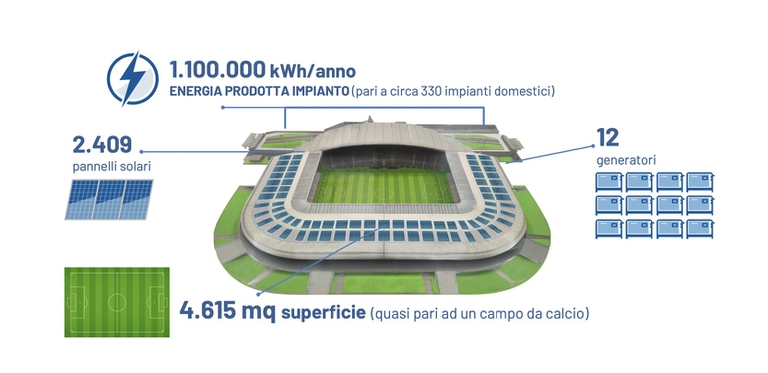https://www.lifegate.it/stadio-udinese-calcio-rinnovabili
- |
- The Bluenergy company and Udinese have started work on the installation of over 2,400 latest generation solar panels on the roof of the Fruli stadium.
- The football field will thus be equipped with a cutting-edge photovoltaic system.The construction site involves the installation of 409 solar panels for a total of 4,615 m2 of surface area.
- The panels will allow the production of an average of approximately 3,000 kWh/day, making the structure partially self-sufficient in energy terms.
Soon it will be possible, for Udinese fans, cheer for your own squad respecting the environment.Their stadium, in fact, is about to become energetically sustainable.The company Udinese Calcio and the energy company Bluenergy Group have jointly announced the start of work for the construction of a cutting-edge photovoltaic system in the stadium owned by the Friulian club, known in the past as Stadio Friuli and recently as Bluenergy Stadium.The system, composed of over 2,400 solar panels of the latest generation, will have the capacity to produce an average of approximately 3,000 kilowatt hours (kWh) per day, thus contributing to making the football pitch one of the most advanced in Europe also in terms of reduction of emissions.
Udinese's sustainable project
The project, managed by Bluenergy Group with the support from the Polytechnic of Milan, involves the installation of 2,409 solar panels on a total surface area of 4,615 square metres.The arrangement of the panels, divided into two parallel sections on the roof, will respect the original architecture of the stadium designed by Studio Casamonti.Furthermore, it is under evaluation the integration of a battery park of storage with a capacity of 330 kW, in order to optimize the charging and discharging cycle and enhance the system.Thanks to this initiative, which is expected to come into force in operation by next October, Udinese takes a significant step towards innovative management of its stadium, making it one of the most sustainable in Europe.Since 2018, the Friulian company Blueenergy is the club's energy partner, providing energy coming exclusively from renewable sources and allowing a saving of 5,620 tons of CO2 to date.This commitment is part of a broader path of energy transition, with the ultimate goal of completely eliminating CO2 emissions.

Udinese's sustainable approach is also reflected in the decision to build the structure on the same site as the previous plant, thus avoiding further consumption of land, and in the partial recovery of the material produced by the demolition.The multifunctionality of the facility, with meeting center, company headquarters and other facilities, responds to one holistic vision of the use of the stadium, promoting a sustainable approach in line with European trends in the context of Sustainability working group of the European club association.Professional sports clubs are required to comply with environmentally friendly regulations like companies in other sectors.
The history of Friuli
The stadium where Udinese plays is known as Friuli, from the name of the region that hosts it.Throughout its history it has seen world-famous footballers tread its green mantle, from the Brazilian Zico up to the German Oliver Bierhoff and the Italian Antonio Di Natale. The Juventus team is a constant presence in Serie A and has even obtained participation in the European competition in the past Champions League.Today, its stadium is the second owned by a club – after Juventus in Turin – and the first stadium sponsored by a commercial brand in Italy;it's a multifunctional facility with 25,132 covered seats numbered with a spectacular diamond aesthetic.The stadium aims to be a reference for the territory, active seven days a week, and also for this reason it is home to Udinese Calcio and the training center of its teams.Work will soon start on the construction of new areas open to the public in correspondence with the curves and distinct areas, including a wellness centre, a medical center and areas dedicated to families.
The total annual energy produced by the plant is 1,100,000 kWh, equal to approximately 330 domestic systems, with an average of around 3,000 kWh/day.This makes the partially self-sufficient structure in energy terms.With the new project, the energy produced daily in excess of consumption and not absorbed by the stadium will be fed into the grid.Each section will in turn be divided into autonomous parts and separated from each other so as to allow timely interventions in the event of a local fault and guarantee continuity of supply.“We are recognized as the most sustainable club in Italy and the fourth in the world and this motivates us to promote, together with a protagonist of the energy transition in our country like Bluenergy, projects that give further impetus to this commitment.The football moves media levers without comparison and we have, in addition to the duty to act virtuously ourselves, that of convey messages that involve fans in a joint action against i climate changes”, said the General Director of Udinese Calcio Franco Collavino. The project will allow to obtain a significant saving of CO2 emissions into the atmosphere, quantifiable in approximately 450 tons/year, the equivalent of 700 trees planted and equal to the emissions of 3,000 cars in a month.In this way, the Bianconeri's goals will be celebrated in a place that is more respectful of the environment and which can be an example for other Italian stadiums.
